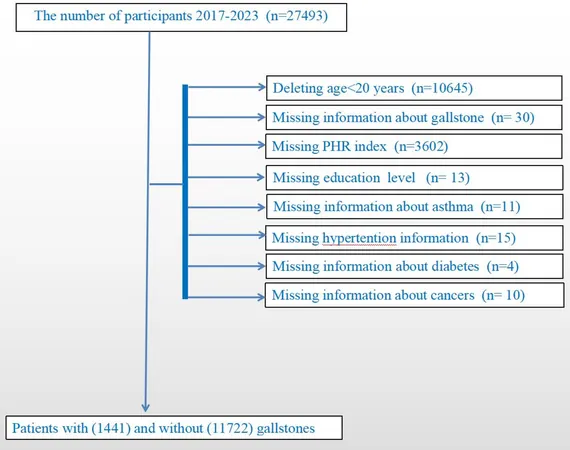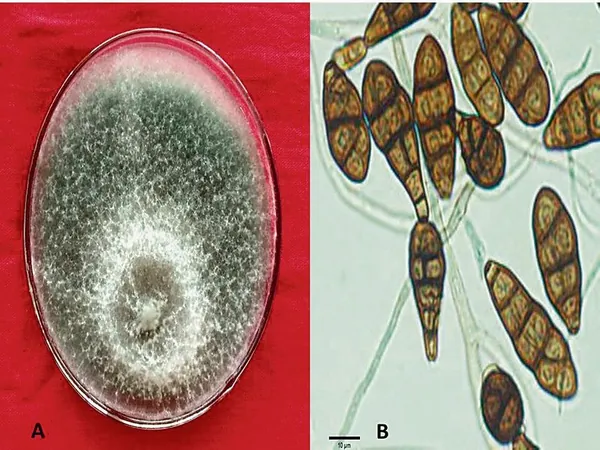
Unlocking the Mystery: How Your Platelet-to-HDL Cholesterol Ratio Could Signal Gallstone Risk!
2025-04-25
Author: Wei Ling
Gallstones: A Hidden Epidemic!
Gallstones are more than just a nuisance—they're a prevailing digestive disorder worldwide that could increase your risk of gallbladder cancer. In the United States, over 10% of adults are affected, often without knowing it. While many live symptom-free, a staggering 25% can develop symptoms like biliary pain, and up to 2% face severe complications. With such serious potential outcomes, the quest for effective early detection of gallstone risk is more crucial than ever.
The Surprising Factors Behind Gallstones!
Recent research highlights a variety of gallstone risk factors, including age, gender, obesity, and diet. But inflammation has taken center stage! Pro-inflammatory markers like IL-6 and CRP are linked to increased gallstone risk, while anti-inflammatory substances like IL-4 seem to help mitigate it.
Platelets and Cholesterol: A Dynamic Duo?
Platelets are more than just blood components; they play a key role in inflammation, releasing cytokines that trigger immune responses. Studies suggest a direct link between high platelet counts and gallstone presence. On the flip side, high-density lipoprotein cholesterol (HDL-C) has been recognized for its protective effects against gallstones. The intriguing balance of these two factors could offer new insights!
Could the Platelet-to-HDL Cholesterol Ratio Be a Game Changer?
Introducing the Platelet-to-HDL Cholesterol Ratio (PHR), a potentially groundbreaking marker for gallstone risk. This study explores its correlation with gallstone prevalence using nationwide survey data—leading to exciting discoveries!
Study Overview: Digging Deep Into Data!
Using the NHANES database from 2017-2023, researchers honed in on participants aged 20 and over, focusing on 13,163 individuals, including 1,441 gallstone sufferers. The PHR was scrutinized as a primary exposure variable, while gallstone presence served as the main outcome.
Analyzing the Results: What Did We Find?
Against a backdrop of demographic, socioeconomic, and clinical factors, the study discovered that a higher PHR correlates with increased gallstone prevalence. Each unit increase in PHR translates to a 20% higher risk of developing gallstones!
A Closer Look: Who’s Most Affected?
Subgroup analyses revealed that individuals under 40 years old showed the strongest correlation between PHR and gallstone risk. Interestingly, while age has traditionally been associated with gallstone development, younger populations battling obesity and metabolic syndrome may be increasingly vulnerable.
The Role of Gender and Ethnicity!
The study confirmed previous findings that females are at a higher risk for gallstones, along with certain ethnic groups, influenced by lifestyle factors and dietary habits.
Connecting the Dots: Metabolic Syndrome and Inflammation!
Consider the connection: the PHR also relates to metabolic syndrome—a known contributor to gallstone development. As obesity and inflammation intertwine, the PHR may serve as an important biomarker, linking metabolic disturbances to gallstone formation.
Next Steps: What Lies Ahead?
Despite the promising findings, the research is not without limitations. The cross-sectional design doesn't confirm causation, and the reliance on self-reported gallstone data introduces potential biases. Future studies should seek to clarify the causal relationship.
Final Thoughts: Is Your PHR Your New Best Friend?
This study shines a light on the Platelet-to-HDL Cholesterol Ratio as a potential game changer in gallstone risk stratification. While it's too early for clinical recommendations, these insights could be pivotal in developing preventive strategies for gallstone disease!




 Brasil (PT)
Brasil (PT)
 Canada (EN)
Canada (EN)
 Chile (ES)
Chile (ES)
 Česko (CS)
Česko (CS)
 대한민국 (KO)
대한민국 (KO)
 España (ES)
España (ES)
 France (FR)
France (FR)
 Hong Kong (EN)
Hong Kong (EN)
 Italia (IT)
Italia (IT)
 日本 (JA)
日本 (JA)
 Magyarország (HU)
Magyarország (HU)
 Norge (NO)
Norge (NO)
 Polska (PL)
Polska (PL)
 Schweiz (DE)
Schweiz (DE)
 Singapore (EN)
Singapore (EN)
 Sverige (SV)
Sverige (SV)
 Suomi (FI)
Suomi (FI)
 Türkiye (TR)
Türkiye (TR)
 الإمارات العربية المتحدة (AR)
الإمارات العربية المتحدة (AR)